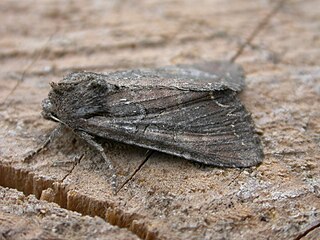
Hippotion celerio, the vine hawk-moth or silver-striped hawk-moth, is a moth of the family Sphingidae. It was described by Carl Linnaeus in his 1758 10th edition of Systema Naturae.

Lacanobia suasa, the dog’s tooth, is a moth of the family Noctuidae. It is found in the Palearctic realm.

Eudocima materna, the dot-underwing moth, is a moth of the family Erebidae found in widespread parts of the world, mainly in tropical Asia extending to New Guinea and Australia as well as in Africa. Reports from the United States, Canada and the French Antilles are now considered to be Eudocima apta. The species can be differentiated from other Eudocima moths by the presence of small central black dot in each hindwing. The species was first described by Carl Linnaeus in his 1767 12th edition of Systema Naturae.

Leucania loreyi, the cosmopolitan, false army worm or nightfeeding rice armyworm, is a moth of the family Noctuidae. It is found in most of African countries, the Indo-Australian subtropics and tropics of India, Sri Lanka, Myanmar, the eastern Palearctic realm, and the Near East and Middle East. The species was first described by Philogène Auguste Joseph Duponchel in 1827.

The silky wainscot is a moth of the family Noctuidae. It is found in most of Europe including Russia.

Lithophane furcifera, the conformist, is a moth of the family Noctuidae. The species was first described by Johann Siegfried Hufnagel in 1766. It is found from central Europe, east to the Black Sea region, the Caucasus and western Siberia. In the mountains, it is found up to elevations of 1,800 meters.

Sideridis turbida, the white colon, is a moth of the family Noctuidae, subfamily Hadeninae. It is found throughout continental Europe, the British Isles and southern Scandinavia.
Helcystogramma melantherella is a moth in the family Gelechiidae. It was described by August Busck in 1900. It is found in North America, where it has been recorded from North Carolina south to Florida and west to Texas and Arkansas.
Sophronia primella is a moth of the family Gelechiidae. It was described by August Busck in 1907. It is found in North America, where it has been recorded Alabama, Illinois, Kansas, Oklahoma, Tennessee, Arizona and Colorado.
Scrobipalpula artemisiella, the thyme moth, is a moth in the family Gelechiidae. It was described by William D. Kearfott in 1903. It is found in the United States, where it has been recorded from California, Arizona, Illinois, Maine, Maryland and Ohio.
Stomopteryx orthogonella is a moth of the family Gelechiidae. It was described by Staudinger in 1871. It is found in central and southern European Russia and Ukraine.
Untomia latistriga is a moth of the family Gelechiidae. It was described by Walsingham in 1911. It is found in Mexico (Morelos).
Untomia rotundata is a moth of the family Gelechiidae. It was described by Walsingham in 1911. It is found in Mexico (Tabasco).
Anacampsis paltodoriella is a moth of the family Gelechiidae. It was described by August Busck in 1903. It is found in North America, where it has been recorded from California, Arizona, New Mexico and Texas.
Aristotelia dasypoda is a moth of the family Gelechiidae. It was described by Walsingham in 1910. It is found in Mexico (Tabasco) and Jamaica.
Aristotelia penicillata is a moth of the family Gelechiidae. It was described by Walsingham in 1897. It is found in West Indies, where it has been recorded from Haiti.
Isophrictis pennella is a moth of the family Gelechiidae. It was described by August Busck in 1907. It is found in North America, where it has been recorded from Arizona.
Taygete sylvicolella is a moth in the family Autostichidae. It was described by August Busck in 1903. It is found in North America, where it has been recorded from Illinois, Maine, New York, Ohio and South Carolina.
Antaeotricha similis is a moth in the family Depressariidae. It was described by August Busck in 1911. It is found in the Guianas and Brazil.
Chlamydastis forcipata is a moth in the family Depressariidae. It was described by Edward Meyrick in 1913. It is found in Colombia.






